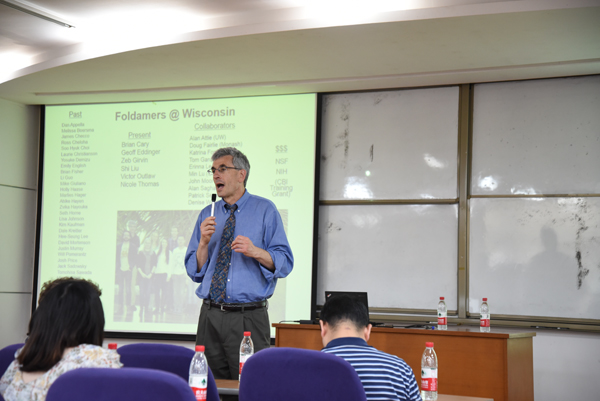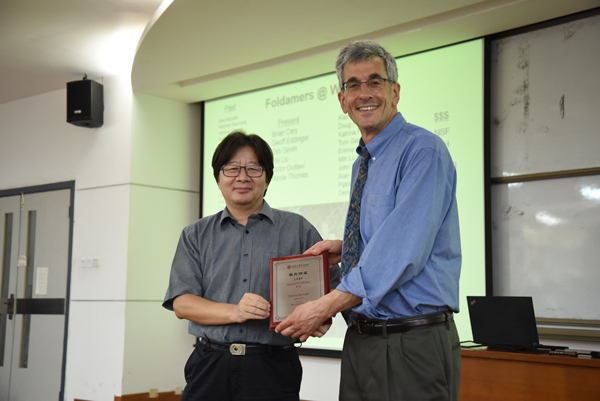On June 1, 2017, as part of our students invited report, the Ralph F. Hirschmann professor Samuel H. Gellman at the university of Wisconsin-Madison (United States) accepted Hu Kuan’s invitation to visit our institute, and had friendly exchanges with teachers and students in our institute. He also had lunch with some teachers and students in the “Zhuyifang” restaurant at noon. At 2:00 in the afternoon, Sam gave a wonderful lecture in room E104 titled as "Impact of Backbone Modifications on Informational Properties of Polypeptides".
Professor Gellman started out with the structure of functional molecules in living organisms, and proposed changes to the functional molecular skeleton, but the concept of a polypeptide molecule that retains information recognition capability. He first introduced the peptide folding body types, said peptide foldamers showed better biophysical properties than that of the peptide, while retaining the peptide molecular recognition capability. Then, professor Gellman revolves around his study in a/β peptide, and talked the important applications in designing protein-protein interaction inhibitor of these kinds of molecules. From using beta or a/β helices inhibiting HIV invasion, he further expounds the 'sequence-based’ a/β peptide design is of great importance. Next, professor tells the story of different a/β model in the importance of protein recognition.
Professor Sam Gellman finally focuses on the a and a/β peptide’s subtle differences in surface, he said that the conformational subtle difference may lead to entirely different in protein recognition selectivity and specificity. Start with the Parathyroid Hormone Receptor 1, he told the selection specificity of the beta-peptides in the receptor different G0 / G1 state. Then use the Glucagon-Like Peptide-1 Receptor as an example, he detailed introduced the discovery of different a->β replacement, can lead to a completely different inner cell signaling pathway activation in cells.
After the report, the teachers and classmates asked questions enthusiastically, professor Gellman made detailed and deeply answer. Finally, professor Ye Tao awarded professor Gellman and a ‘NanYan’ professor in our institute.(Written by Kuan Hu;Photen by Ke An)


SAMUEL H. GELLMAN (University of Wisconsin - Madison, Department of Chemistry, Madison, Wisconsin).
Education:
1986 Ph.D., Chemistry, Columbia University
1981 B.A., Chemistry, Harvard University
Professional Experience
1985-1987 California Institute of Technology; NIH Post-Doctoral Fellow
Professor Peter Dervan, research advisor
1987-1993 University of Wisconsin - Madison; Assistant Professor of Chemistry
1993-1995 University of Wisconsin - Madison, Associate Professor of Chemistry
1995-2001 University of Wisconsin - Madison, Professor of Chemistry
2001-2006 University of Wisconsin - Madison, Evan P. Helfaer Professor of Chemistry
2005-present University of Wisconsin - Madison, Ralph F. Hirschmann Professor of Chemistry,
Honors
Fellow, National Academy of Inventors, 2014; Member, National Academy of Sciences, 2014; Ronald Breslow Award in Biomimetic Chemistry (American Chemical Society), 2014; Makineni Lecture Award (American Peptide Society), 2013; Fellow, American Academy of Arts & Sciences, 2010 and so on.
Research Interests
Organic and biological chemistry, including: the design of new oligomers with well-defined folding properties ("foldamers"), and their use in antimicrobial therapy, for inhibition of protein-protein interactions and other biomedical applications; the origins of protein conformational preferences; new amphiphiles for membrane protein solubilization and crystallization; synthesis and biological applications of poly-betapeptides (nylon-3 materials).